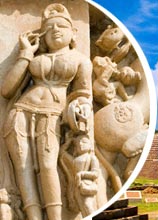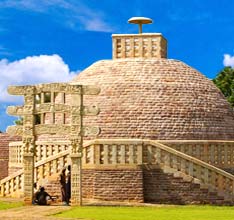 Pench
National Park falls under the Seoni and Chhindwara districts of Madhya
Pradesh. It derives its name from the Pench River that flows through its
heart and divides it into two, equal western and eastern halves -
Chhindwara and Seoni respectively. Declared as a wildlife sanctuary in
1977, eventually the place got elevated to the status of a National Park
in 1983. Later, its eminence led to its incorporation under the umbrella
of 'Project Tiger', as the 19th Project Tiger Reserve, in 1992. Sited on
the southern fringes of Madhya Pradesh, the park covers a total area of
757.89 sq. km. Jabalpur and Nagpur serve as convenient airheads and
railheads for reaching the park.
Pench
National Park falls under the Seoni and Chhindwara districts of Madhya
Pradesh. It derives its name from the Pench River that flows through its
heart and divides it into two, equal western and eastern halves -
Chhindwara and Seoni respectively. Declared as a wildlife sanctuary in
1977, eventually the place got elevated to the status of a National Park
in 1983. Later, its eminence led to its incorporation under the umbrella
of 'Project Tiger', as the 19th Project Tiger Reserve, in 1992. Sited on
the southern fringes of Madhya Pradesh, the park covers a total area of
757.89 sq. km. Jabalpur and Nagpur serve as convenient airheads and
railheads for reaching the park.Landscape and Flora
The flora of Pench Tiger Reserve comprises mainly of Southern Indian tropical moist deciduous forest and tropical dry deciduous teak. Water bodies are found in the form of streams and 'nallahs'. Most of them are seasonal and meander in full zest during the monsoons. Pench River, which serves as the major water source, desiccates or dries up in April end. Then, water pools known as 'dohs' serve as water suppliers for the fauna of the park, along with Pench Reservoir. Teak is abundant and bamboos are sparse, and restricted to the valleys. White kuku trees are very common and stand out prominently amidst the greenery.
Fauna and Avifauna
Tigers are usually seen around the Pench River, as the density of prey population is higher here. There are 25 tigers recorded in this park. It is also the jungle abode of 39 species of mammals, 13 species of reptiles, 3 species of amphibians and over 170 varieties of birds. Major species of fauna include leopards, cheetal, sambar, nilgai, jackals, wild dogs, gaur, sloth bears, langoors, small Indian civets and palm civets. There are also more than 210 species of birds, including a host of migratory species. The most common birds are peafowl, crow pheasant, crimson breasted barbet, red vented bulbul, red jungle fowl, racket tailed drongo, magpie robin and whistling teal.










